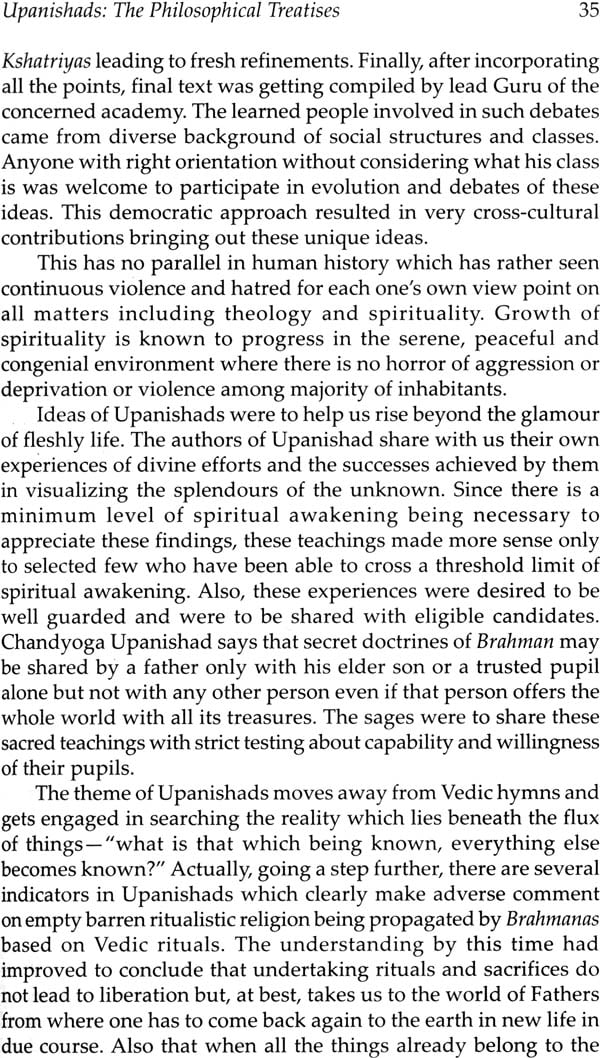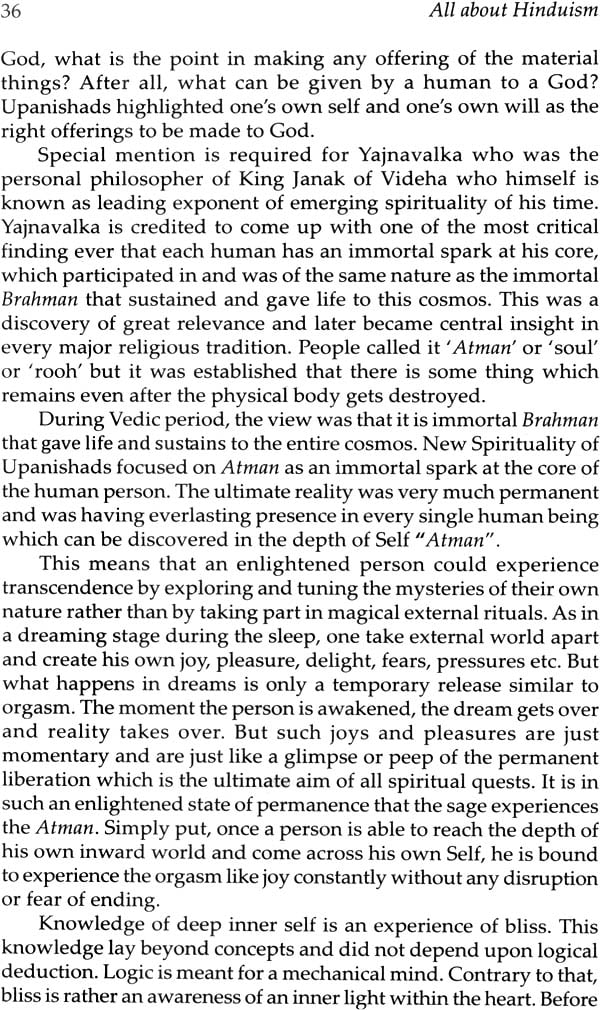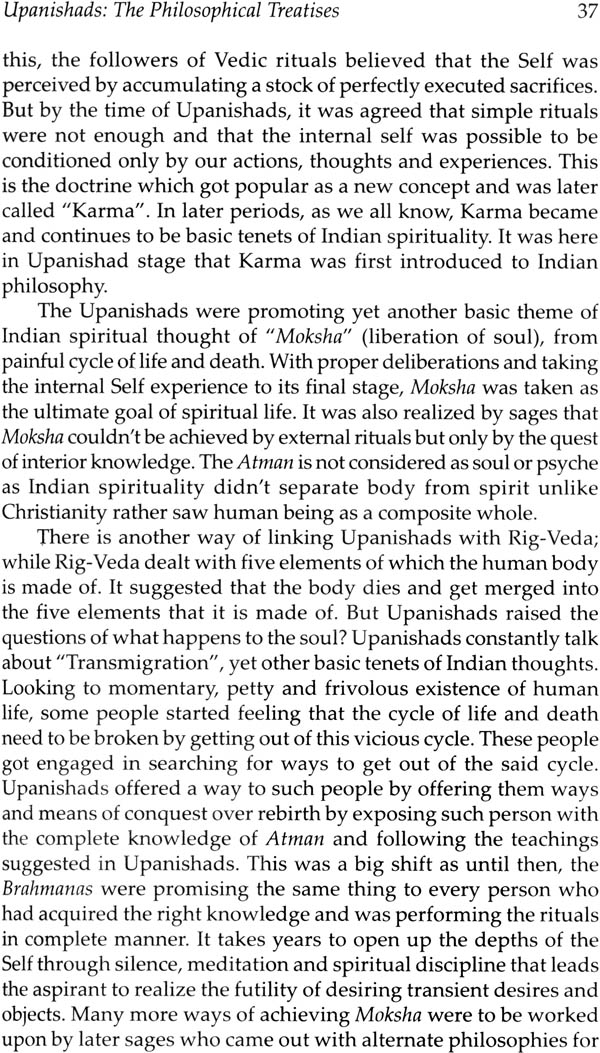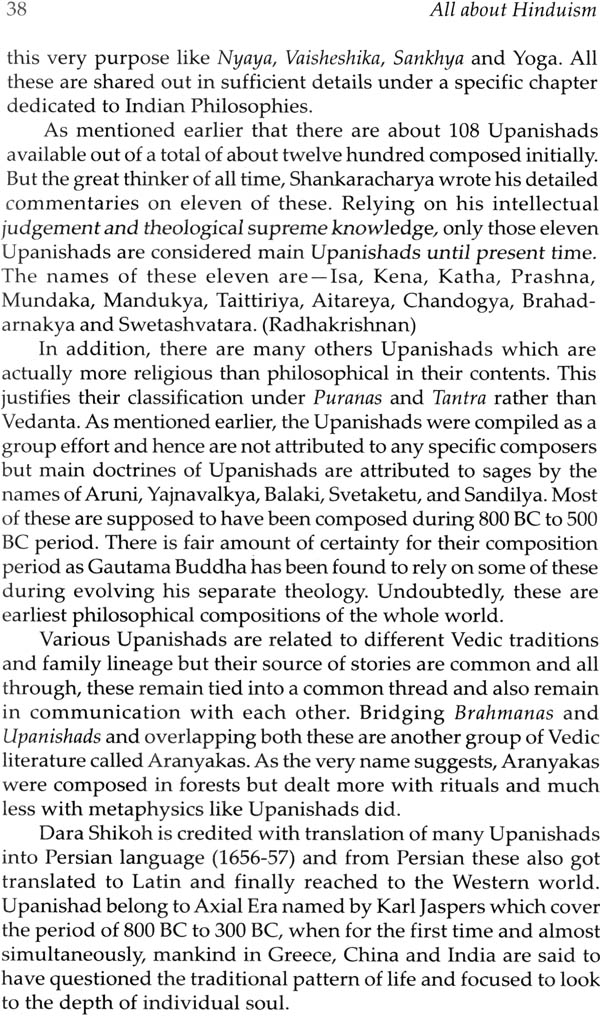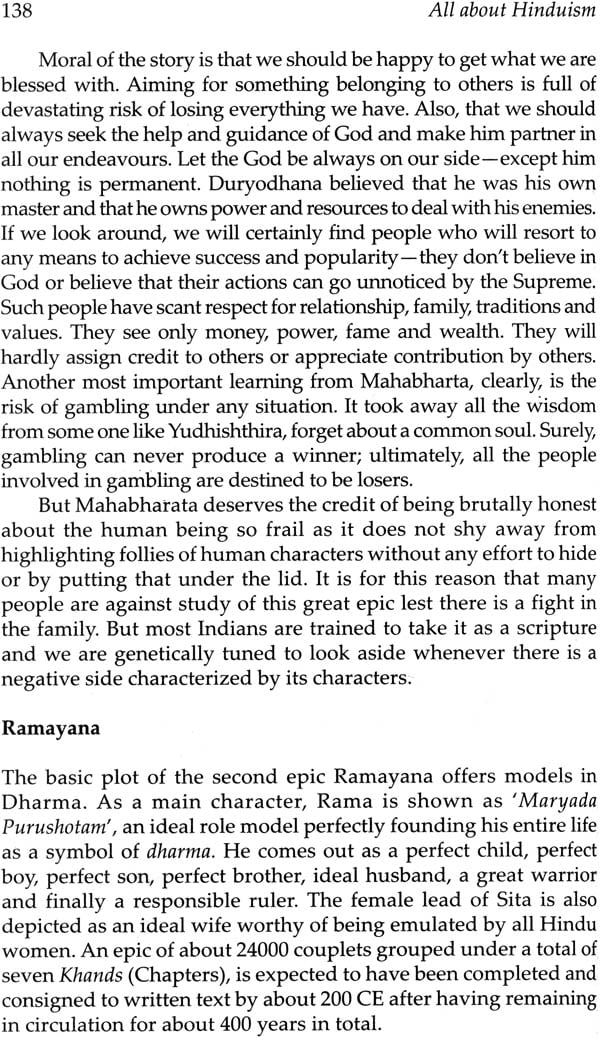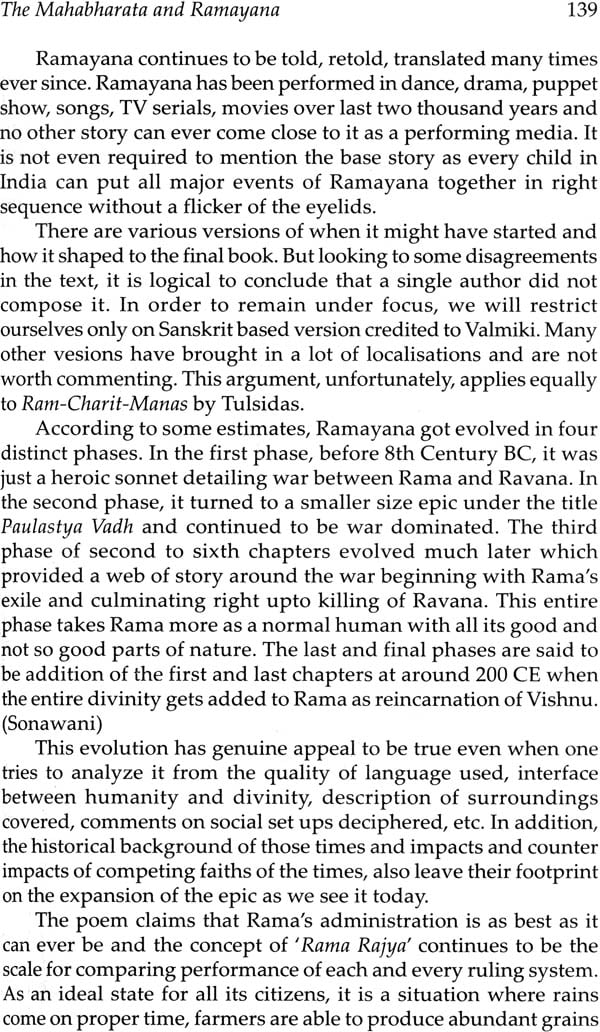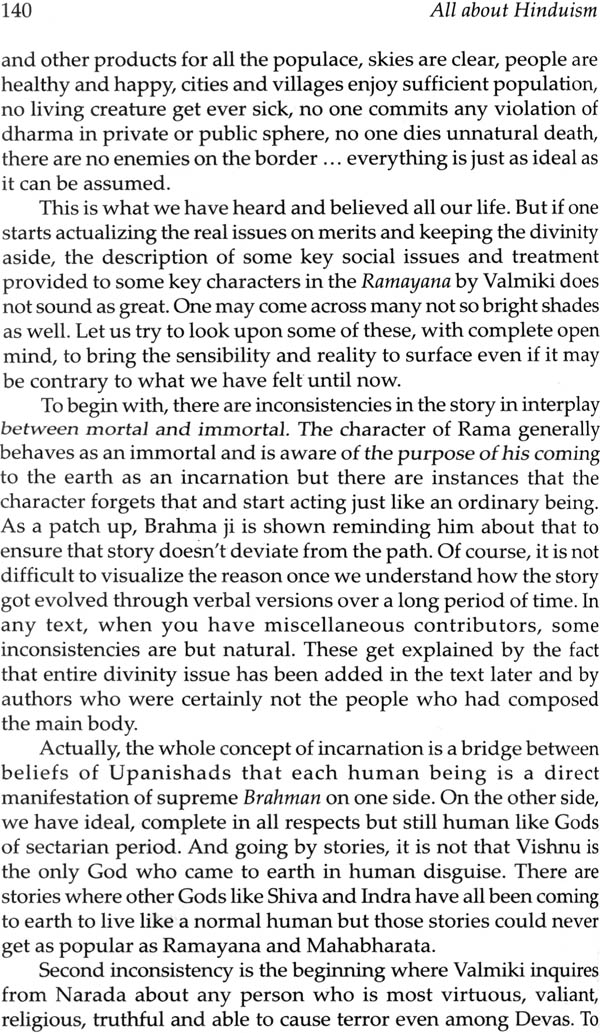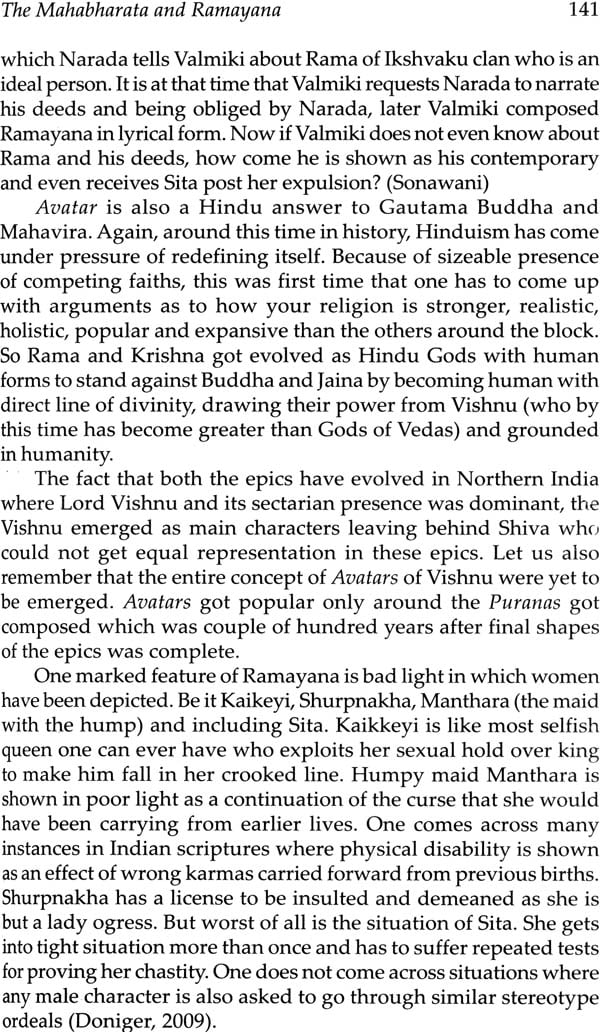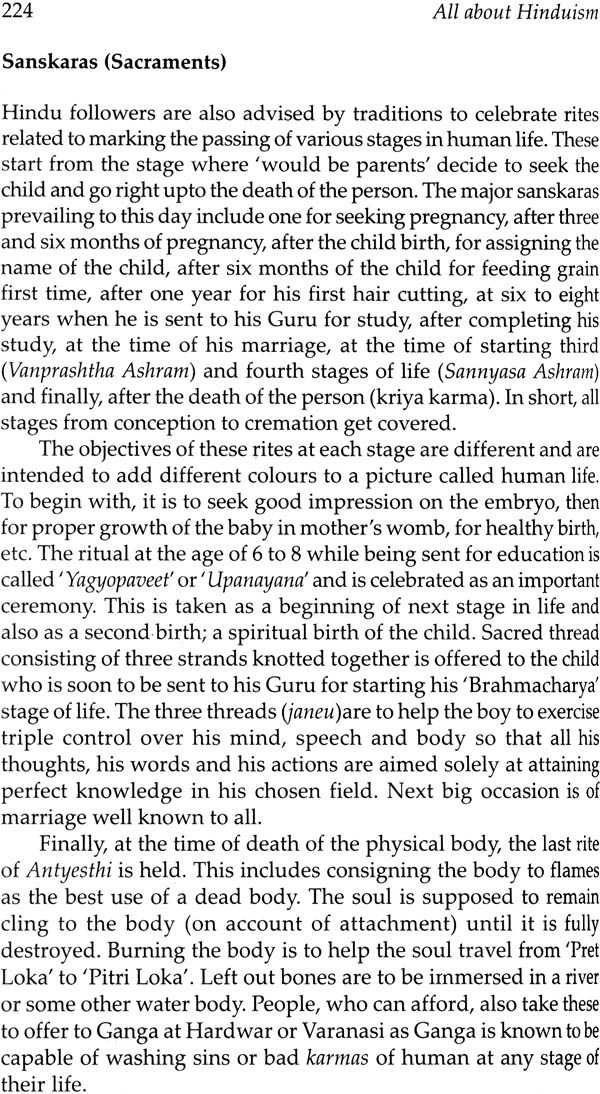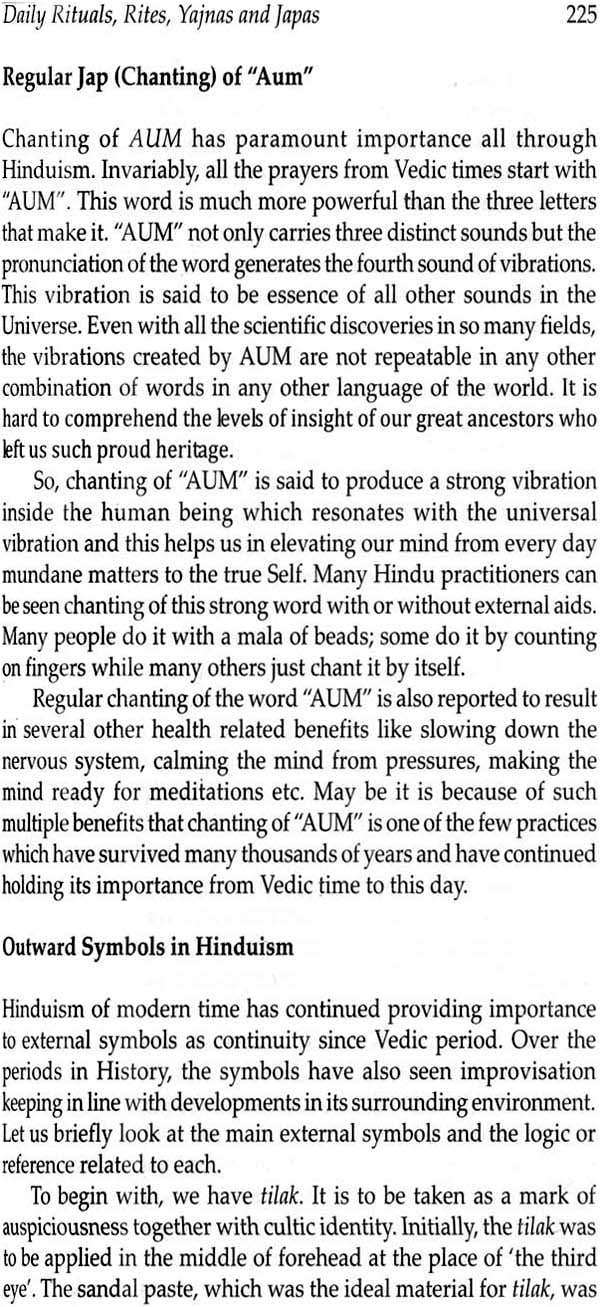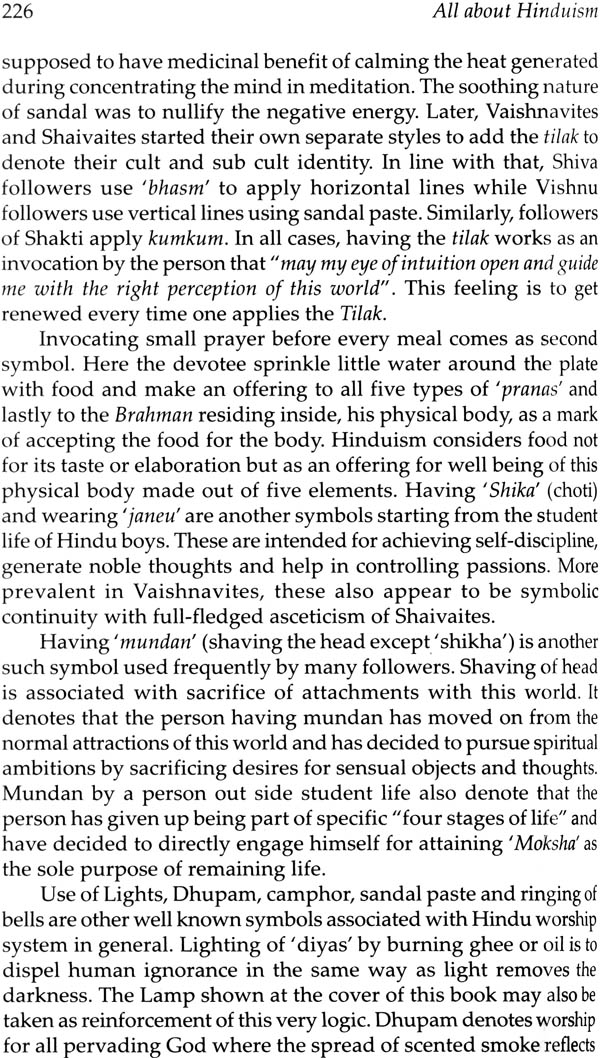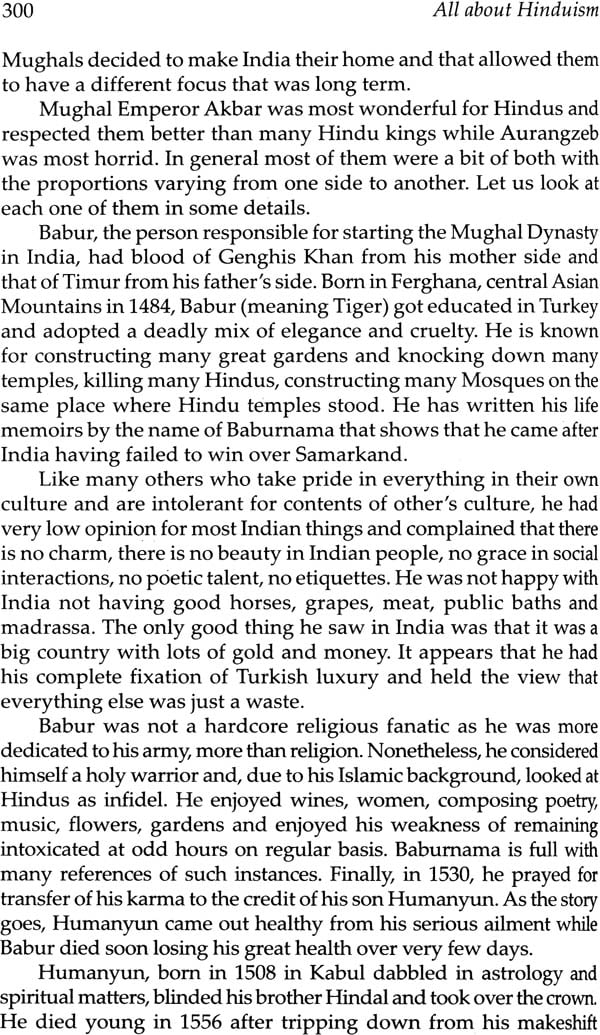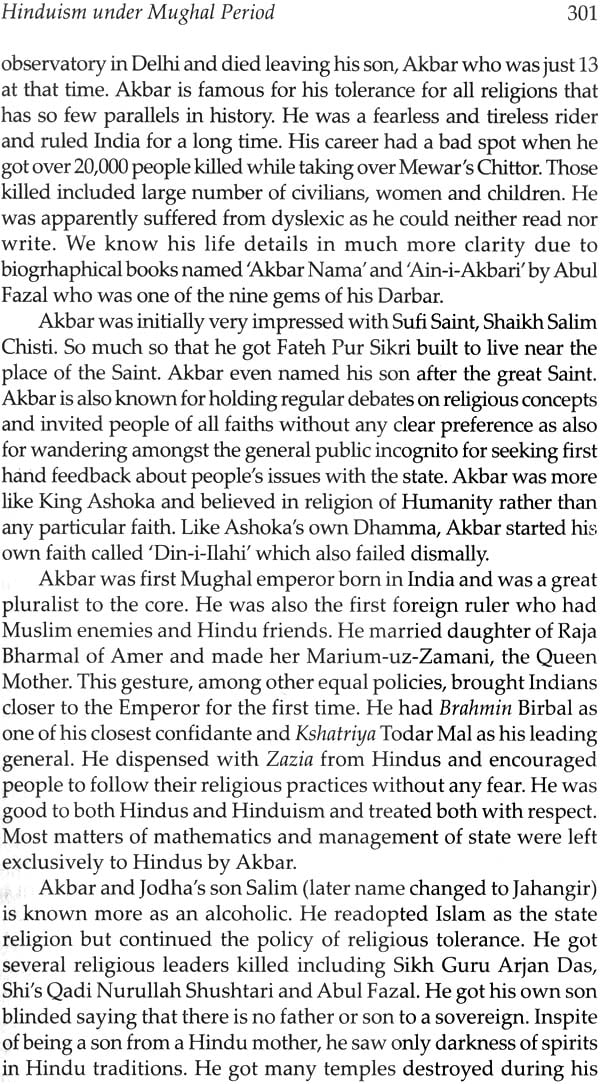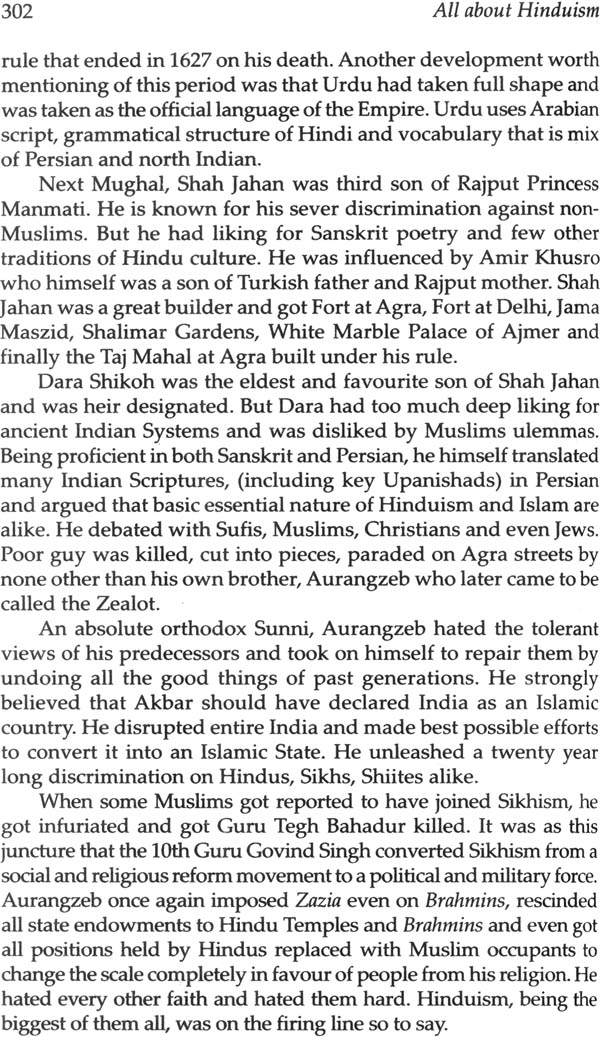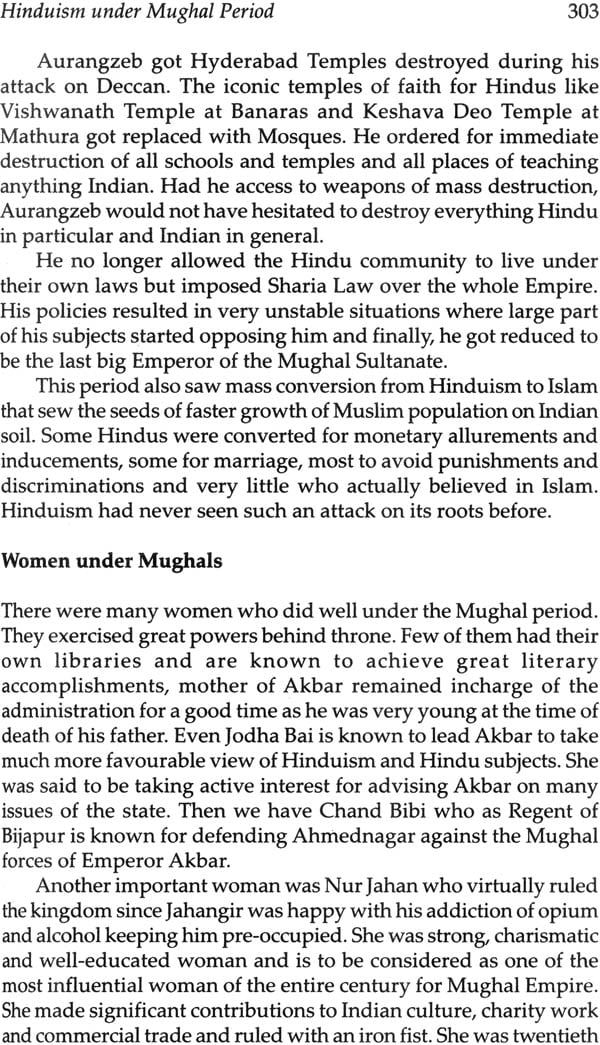
All About Hinduism (From Vedas to Devas and Past to Present)
Book Specification
| Item Code: | NAL081 |
| Author: | Ashok Tyagi |
| Publisher: | Shipra PRAKASHANI |
| Language: | English |
| Edition: | 2015 |
| ISBN: | 9788175417960 |
| Pages: | 392 |
| Cover: | Hardcover |
| Other Details | 9.0 inch X 6.0 inch |
| Weight | 600 gm |
Book Description
This book, meant for the present generation interested in understanding Hinduism, covers its entire history of 5000 years in a capsule form. It endeavours to expose its readers to the great Indian heritage of Vedas, Upanishads, Epics and Puranas. At the same time, it touches upon critical doctrines, philosophies and other components that make Hinduism a ‘Way of Life’, different from other home grown and prophetic religions of our time.
The book raises the curtain from several popular myths surrounding our epics and the scientific advancement claims during ancient India. It also raises the veil from key issues, such as humanity /divinity of lord Rama and Krishna, Aryans and their arrival in India, the Saraswati River and its disappearance, period of the composition of Vedas, etc.
Hinduism is considerably greater than the way of worshipping associated with it. Needless to add, it is a great heritage that has made universal and timeless global contributions for enlightening and sustaining the entire humanity
Ashok Tyagi (1960), Chartered Accountant, brings a world-view rooted in pragmatism of an immensely successful corporate Chief Executive. His hands-on understanding of religio-cultural nuances evolved out of studies of several belief systems being practised the world over. The essential goodness of human beings versus existential need of religion helped him pursue his drive to re-visit Hinduism, the religion of his birth. His renunciation of blind-faith makes him a present day thinker with Indian roots. He dedicate this lucid insight to the children and the curious.
Mr.Tyagi, a modern hermit, pursues intellectual vocation living in Surabaya, Indonesia with his wife Esha.
Most of the educated, urban and modern-day Hindus proudly identify themselves as being liberal,tolerant and more secular than followers of some other belief systems. However, when it comes to deeper questions relating to the finer doctrines, theology, metaphysics of religion, mythology vs. reality, and the forms of God, one tends to get entangled in generalities rather than having specific answers. A question that may seem simple at first like the difference between Hinduism as a way of life and as a religion may baffle many of us as Hinduism like any other religion is a complex subject with many mysterious facets which is difficult for most to comprehend.
Although there is a rich literary stream replete with explanations claiming to present interpretation of esoteric concepts in apparently intelligible way, there is an obvious dearth of a genuine source of information about a macro-perspective on the subject. One can always find bits and pieces of information on the history and growth of Hinduism but to put together all the pieces of the puzzle not only requires the tedious task of dealing with varied languages, styles and aphorisms but also trusted translations and commentaries that offer an analysis that is not overly academic or abstruse for an ordinary man to understand.
Most Hindus today are aware of Hinduism's esteemed heritage here several Rishis and Munis achieved insurmountable accomplishments in all spheres of humanity and much ahead than a lot of other cultures, both surviving and dead. In spite of the challenges posed by the modern day life pressures, more and more adults are keen to get in touch with their spirituality or connect with their roots like never before. More and more people are aspiring to gain a deeper understanding of their religion out of sheer curiosity as well as with a desire to pass on such knowledge about their culture and "Sanskar" to their next generations. Studies suggest that youngsters today are more inclined towards acquiring theological knowledge in comparison to the previous generations -one reason may be their heightened exposure to information in comparison to previous generations who were preoccupied with either the freedom struggle or struggling to arrange their economic means of survival.
India's cultural evolution is full of steep ups and downs as well as twists and turns similar to most long journeys passing through unchartered territories. To make matters worse, a good part of it dates back to an epoch when all forms of knowledge and wisdom were passed onto generations merely by the spoken word. No wonder that a large part of our history is recorded in the form of thoughts and words. It is a different matter, however, that these very words and thoughts became revelations recorded as sacred scriptures that came to be known as Vedas and Upanishads that are highly regarded and appreciated by the entire world as one of the finest human creations relating to the inner psychic world of human beings.
We often see panelists on prime time national TV programmes representing different religions embroiled in debates trying to prove the superiority of their own religion over others. In such situations, one generally feels under-qualified to form an opinion or even sceptical about the truths. At that point it becomes clear that to have an understanding of the comparative positions between different religions, one should not only have a grasp of his/her own religion but also a certain degree of exposure to the basics of other religions as well. In a secular society like India that is truly a bouquet of diverse flowers, it becomes a necessity to gain an insight on the fundamentals of other religions lest real facts be overlooked.
I am able to relate myself with these scenarios completely. My own childhood was typical of children from middle-class families where we all get from our parents regular words of encouragement for doing good deeds to accumulate good karmas(deeds) and instilling fear of God for all wrong-doings. These teachings were coupled with occasional visits to temples to cement the belief in the existence of an omnipresent God. However, having lived a major part of my initial childhood with my grandfather, I was constantly nudged by him to read religious books (including Ramayana, Mahabharata, Puranas and story books such as Panchatantra). He would also cross-examine me about references from various books as riddles and answering those correctly meant earning brownie points. It was his ideas that drew me closer to our scriptures and other concepts that, much later, I was to understand as tenets of Hinduism (not sure if such tricks can be played anymore on youngsters from current generation). In his later years, my father also was to spend more of his spare time in reading of Hindu scriptures and I used to wonder why one should spend so much time with religious books and why should he need to read the same book so many times over. It didn't make so much sense at that time.
After school and college, professional education takes lot of energy and there is no time for exploring God and his designs as His endless hurdles of real life become more urgent to cross over. Later life grips with all its pulls and pressures. Marriage, career advancement, and children result in forced suppression of time for learning for everything religious. Desire still remains, sometimes even strong, but neither there is inclination to pursue nor vigour to go deep in developing understanding for religions in a serious way. Real world, in that respect, is certainly cruel and demanding.
For many of us who are exposed to working with people from other cultures and religious leanings, the desire for seeking deeper understanding about our own religion may also come from external comers. For example, in my first ten years of working outside India, I got into situations with people from very diverse cultural backgrounds who came out showing obvious curiosity for Indian culture in general and Hinduism in particular.
On my own part, sharing unique features from Indian culture as always fulfilling and at one such engagement, my guest preferred discussing about specific role of Brahmins in Indian religious evolution and cultural landscape. On being told that I myself am a Brahmin by birth, his questions became even more penetrating and embarrassing. Apparently he knew well in detail about our caste system, Vedas, Shastras and the likes. Honestly, I was found wanting on quite a few questions and felt very small that he knew about Indian heritage much more than I did. And this was not the first time that I felt so.
Surely, knowing about Hinduism is very complex. There are so many versions for each issue and everything always remain in a flux of uncertainty. Nobody seems to be eying for finality in any manner. It is like a miracle that we are all Hindus inspite of all the 'Diversities' that we have. Clearly, that so called 'Unity' evades the naked eye on every plain. After all, there are so many scriptures, so many Gods, so many branches and so many languages. Then we have a vast history of over five thousand years with so much of transformations happening all the time. One constantly hears that Hinduism is not a religion but a "way of life" or as Atal Bihari Vajpayee often said "Unity in Diversity" but one can better appreciate this entire philosophy after going over following ruling by Supreme Court of India in one of its landmark judgment and it said:
"Unlike other religions in the world, the Hindu religion does not claim anyone Prophet, it does not worship anyone God, it does not believe in anyone philosophical concept, it does not follow anyone act of religious rites or performances; in fact, it does not satisfy the traditional features of a religion or creed. It is a way of life and nothing more. "
I am sure every reader will appreciate this dilemma in very clear light by the end of the reading of this very book. Because more we know about Hinduism, more we tend to realize how little we knew about it. It is indeed beyond any single human to completely understand every single concept and aspect of Hinduism in one's lifetime.
Coming back to my own experience, soon after completing my fiftieth year, events culminated fast, one after another, and made it possible for me to opt for a life of Vanprashtha, albeit in modified form. Today, I will certainly call it some divine intervention that prompted me to give up the career as CEO of an established company, at the age of 51 and pursue learning about Hinduism and its surroundings as a full-time passion with a new found vigour. Over next couple of years, I could switch from one source to another sniffing about Vedas, Upanishads, and evolution of Hinduism and all other social surroundings influencing and getting influenced with its evolution. Soon came the realization that just going deep into Hinduism is not enough as nothing grows in isolation. Every development has a cause and effect, and sometimes an interlinked chain of events is inseparably intertwined with each other.
This guided me to look for historical perspectives on one side and study of parallel religions of Buddhism and Jainism as home grown faiths on the other side. Similarly, Islam has been communicating with Hinduism in India for over a thousand years and at times involving strong arguments and even violent confrontation. Even Christianity has been in direct communication with Hinduism for last three hundred years or so and, for most part, as a religion of the rulers of the land. A good reflection on these religions is, therefore, quite essential for understanding some twists and turns within Hinduism. ever before had I realized the extent of influence absorbed by Hinduism emerging out of some sweet and some sour interactions with these religions. This study also brought out the unique ability of Hinduism of its readiness and openness to absorb new concepts and traditions from other religions almost so regularly. Its open arm ability to absorb new concepts and traditions help it maintain its virility all through its journey. There is no parallel to this ability of Hinduism in any other religion the world over. Similarly, deeper understanding about other religions helps one establish stark similarities and differences which in turn force you to go to the logics and take a call on its being right or wrong.
| Preface | v | |
| Glossary | xix | |
| 1 | Hinduism: An Introduction | 1 |
| Social Structure during Early Vedic Period | 13 | |
| 2 | The Vedas: A Great Human Heritage | 18 |
| Rig-Veda | 20 | |
| Other Three Vedas | 26 | |
| The Brahmanas | 29 | |
| 3 | Upanishads: The Philosophical Treatises | 32 |
| Contributing to the Theology of Ancient Hinduism | 32 | |
| 4 | Traditions of Shramana | 40 |
| 5 | Harappan Civilization and Vedic India: Two Sides of the Same coin | 44 |
| Interesting Findings | 46 | |
| Major Break-Through | 46 | |
| 6 | Unique Hindu Doctrines | 54 |
| Reincarnation | 55 | |
| Karma-Samsara | 55 | |
| Accumulated Karma as the Cause of Reincarnation | 57 | |
| Life Divided in Four Stages | 57 | |
| Society Divided in Four Classes | 64 | |
| Sadachar (Critical Virtues) | 67 | |
| 7 | Sanskrit: The Language of Hinduism | 73 |
| The Tree of Languages | 74 | |
| Stages of Sanskrit: Excellence Refined | 78 | |
| Sanskrit's Literary Treasure: Broad Classification | 80 | |
| Sanskrit's Relation with Hindi | 88 | |
| 8 | Emergence of Buddhism | 90 |
| The Basic Four Truths Doctrine by Buddha | 92 | |
| Noble Eight-Fold Path | 93 | |
| Meditation Teachings by Buddha | 95 | |
| Personality Described | 96 | |
| Selected Clauses from Dhammapada | 97 | |
| Concept of Nirvana in Buddhism | 99 | |
| Concept of Boddhisattva | 99 | |
| Branches of Buddhism | 100 | |
| Buddhism and Hinduism | 101 | |
| 9 | Jainism | 104 |
| Teachings of Mahavira | 105 | |
| 10 | Hinduism during Mauryan Empire | 110 |
| Resurrection of Classical Hinduism | 113 | |
| 11 | Comments on Major Shastras | 116 |
| Dharma Shastra | 116 | |
| Artha Shastra | 118 | |
| Kama Shastra | 120 | |
| 12 | The Mahabharata and Ramayana | 125 |
| Historical Perspective of the Period of their Compositions | 125 | |
| Mahabharata | 128 | |
| Ramayana | 138 | |
| Bhagvad Gita and Its Teachings | 145 | |
| 13 | Emergence of Caste System in Hinduism | 154 |
| 14 | Golden Period of Indian Civilisation | 158 |
| 15 | Yoga: The Spiritual Connect of Hinduism | 162 |
| The Raja Yoga | 165 | |
| Steps to Achieve Final Goal | 167 | |
| Karma Yoga (The Yoga of Action) | 175 | |
| Bhakti Yoga (The Yoga of Devotion) | 176 | |
| Gyan Yoga (The Yoga of Knowledge) | 176 | |
| 16 | Composition of Puranas | 178 |
| Historical Perspective at the Time of Writings of Puranas | 178 | |
| Socio-Cultural Background | 180 | |
| Numbers and Classifications | 181 | |
| Language and Content | 182 | |
| Hinduism Goes out of Hands of Brahmins | 182 | |
| Shiva and Vishnu Calling Shots | 183 | |
| 17 | Sects of Hinduism | 190 |
| Shaivism | 192 | |
| Vaishnavism | 193 | |
| Shaktism | 194 | |
| Tantraism | 194 | |
| Brahamanism | 196 | |
| 18 | Purusharthas in Hinduism | 199 |
| Very First Aim of Life - Dharma | 201 | |
| Second Aim of Life - Artha | 202 | |
| Third Aim of Life - Kama | 204 | |
| Final Aim of Human Life - Moksha | 205 | |
| 19 | Beginning of Murti Puja (Idol Worship) | 207 |
| 20 | Evolution of Temples and Allied Practices | 212 |
| Forms and Types of Hindu Temples | 215 | |
| Major Temples of India | 217 | |
| North Indian Temples and Foreign Aggressors | 220 | |
| 21 | Daily Rituals, Rites, Yajnas and Japas | 222 |
| Vedic Fire Ceremonies | 222 | |
| Daily Rituals | 223 | |
| Sanskaras (Sacraments) | 224 | |
| Regular Jap (Chanting) of "Aum" | 225 | |
| Outward Symbols in Hinduism | 225 | |
| 22 | Indian Philosophies | 228 |
| Categorisation of Indian Philosophical Schools | 230 | |
| Sankhya Philosophy | 231 | |
| Yoga Philosophy | 234 | |
| Nyaya (Logical Reasoning) Philosophy | 235 | |
| Vaisheshika Philosophy | 237 | |
| Mimamsa (Critical Inquiry) Philosophy | 239 | |
| Vedanta Philosophy | 240 | |
| Charvaka Philosophy | 243 | |
| Ajivika Philosophy | 244 | |
| Buddhist Philosophy | 245 | |
| Jain Philosophy | 246 | |
| 23 | Emergence of Islam from Arabia | 248 |
| Pre-Islamic Arabia | 249 | |
| The Qur'an as a Piece of Fine Literature | 252 | |
| Islam's Attitude Towards Other Religions | 254 | |
| Violence and Islam | 255 | |
| Condition of Women in Islam | 257 | |
| Sects in Islam | 259 | |
| Sunnah, Hadith and Shariah | 260 | |
| 24 | Adi Shankaracharya: The Scriptor of Modern Hinduism | 262 |
| Akharas and Naga Sadhus | 265 | |
| 25 | Other Elements of Later Hinduism | 268 |
| Forms of Gods | 268 | |
| Murti Puja (Idol Worship) | 269 | |
| Importance of Cow | 271 | |
| Triads of Hinduism | 272 | |
| 26 | Ancient India: Advancements in Sciences | 274 |
| 27 | Position of Women: From Ancient India to Present | 280 |
| 28 | Hinduism under Delhi Sultanate | 289 |
| 29 | Bhakti Movement in Hinduism | 292 |
| 30 | Hinduism under Mughal Period | 299 |
| Women under Mughals | 303 | |
| Religious Fusion around this Time | 304 | |
| 31 | Social Evils Manifesting in Medieval India | 305 |
| 32 | Hinduism Under British Raj | 313 |
| Social Significance of Britishers Arriving in India at Different Periods | 316 | |
| The Great Indian Rebellion of 1857 | 318 | |
| Social Reform Movement of 19th Century | 320 | |
| Main Social and Religious Organisation during Raj | 324 | |
| 33 | Hinduism and Independent India | 330 |
| 34 | Global Spread of Hinduism | 336 |
| 35 | Sanatan Dharma: The Real Hinduism | 342 |
| 36 | Challenges Being Faced by Hinduism | 349 |
| Apathy in Education | 349 | |
| Lack of Public Debates about its Character | 350 | |
| Resurrection of Intellectual Discussions | 350 | |
| Focus on Whole rather at its Parts | 351 | |
| Need for Combining Hinduism with Ayurveda, Vedanta and Astrology | 351 | |
| Forcing Support from Governments | 352 | |
| Promote Unity among all its Practitioners | 352 | |
| Not to Shy Away from its Superiority | 353 | |
| Promote its Unity on Collective Basis | 353 | |
| Need for Shunning Caste and Creed differentiations | 354 | |
| Extend Protection to Weak and Suppressed | 355 | |
| 37 | Future of Hinduism | 356 |
| Bibliography | 360 | |
| Index | 362 |
